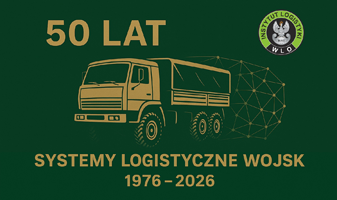ORIGINAL PAPER
LOGISTICS LOADED WITH SUPPLY CHAINS
1
Akademia Marynarki Wojennej
Wydział Dowodzenia i Operacji Morskich
A - Research concept and design; B - Collection and/or assembly of data; C - Data analysis and interpretation; D - Writing the article; E - Critical revision of the article; F - Final approval of article
Publication date: 2020-12-31
SLW 2020;53(2):33-51
KEYWORDS
ABSTRACT
The paper presents an open discussion on the role, place and meaning of traditional logistics in the process of supply chain management. For this purpose, selected definitions of supply and logistics chains were provided, which were used to identify systemic interdependencies and relationships between these categories. The introduction presents the origins and military roots of the concept of logistics, which only began to function in the structure of various supply chains on the basis of the market economy. Next, the most popular definitions of supply chains in the literature, oscillating around its traditional functional and organizational concepts, are discussed in detail. The place of classic logistics processes, such as transport, storage and packaging, in shaping the functionality of supply chains was also indicated. Service logistics acts as a kind of binder connecting individual links in the supply chain, guaranteeing its consistency and functional continuity. The subject of specific analyzes was the discussion about the supply or demand nature of the supply chain. From the point of view of the principles of market economy, the dominant determinant of the supply chain should be its suction function, illustrating the primacy of market demand over secondary market supply. It is the primary needs of customers, i.e. market demand, that determine the purposefulness of a specific supply chain. Unfortunately, the supply chain dominating in the literature clearly prefers the supply side, which constitutes a kind of antithesis of the market economy. Due to the numerous controversies surrounding the title concept of "supply chain", its logistic aspects were analyzed: market relations of demand - supply, network and chain structure, assortment diversity, spatial extent and synergistic effects generated by it. Finally, the semantic-set relationship between the concept of logistics and the supply chain was examined. The aim of the work was the authors' voices on a question as debatable and probably never closed as the relationship between the logistics approach and the pragmatics of supply chains. The method of review and critical analysis of the literature was used to investigate this problem, concluding with the comments and conclusions drawn from the research.
PEER REVIEW INFORMATION
Article has been screened for originality
REFERENCES (29)
3.
BOZARTH, C., HANDFIELD, R.B. (2007). Wprowadzenie do zarządzania operacjami i łańcuchami dostaw. Gliwice: Helion S.A.
4.
CHABEREK, M. (2005). Makro i mikroekonomiczne aspekty wsparcia logistycznego. Gdańsk: Wyd. UG.
5.
CHRISTOPHER, M. (1998). Logistyka i zarządzanie łańcuchem podaży. Kraków: Wyd. PSB.
6.
CHRISTOPHER, M. (2000). Logistyka i zarządzanie łańcuchem dostaw. Warszawa: Wyd. Polskie Centrum Doradztwa Logistycznego.
7.
CIESIELSKI, M. (2002). Teoretyczne podstawy sieci logistycznych. [w:] Sieci logistyczne. Ciesielski, M. (red.), Poznań: Wyd. A E.
9.
CIEŚLIK, M. (red.). (2004). Prognozowanie gospodarcze. Metody i zastosowania. Warszawa: WN PWN Warszawa.
10.
COYLE, J.J., BARDI, E.J., LANGLEY, C.J. (2002). Zarządzanie logistyczne. Warszawa: PWE.
12.
FICOŃ, K. (2004). Logistyka operacyjna. Na przykładzie resortu Obrony Narodowej. Warszawa: BEL Studio.
13.
FICOŃ, K. (2015). Trzy logistyki. Wojskowa, kryzysowa, rynkowa. Warszawa: BEL Studio.
14.
FICOŃ, K. (2017a). Chmura pojęciowa wybranych definicji logistyki rynkowej. Systemy Logistyczne Wojsk, (46), 35-50.
16.
FICOŃ, K. (2018). Próba formalizacji podstawowych pojęć i definicji z obszaru zarządzania logistyką. Systemy Logistyczne Wojsk, (48), 54-77.
17.
GOŁEMBSKA, E. (1994). Logistyka jako zarządzanie całym łańcuchem dostaw. Poznań: AE.
19.
KORZAN, B. (1978). Elementy teorii grafów i sieci. Metody i zastosowania. Warszawa: WN-T.
22.
PIOTROWICZ, A. (2018). Wymagania organizacyjne stojące przed podmiotami gospodarczymi w obliczu globalnej konkurencji. s. 45 (https://docplayer.pl/1570867).
23.
PSZCZOŁOWSKI, T. (1978). Mała encyklopedia prakseologii i teorii organizacji. Wrocław-Warszawa-Kraków-Gdańsk; Wyd. ZN Ossolineum.
24.
RUTKOWSKI, K. (2004). Zarządzanie łańcuchem dostaw–próba sprecyzowania terminu i określenia związków z logistyką. Gospodarka Materiałowa i Logistyka, 12.
27.
TARASIEWICZ, R. (2014). Jak mierzyć efektywność łańcuchów dostaw? Warszawa: Wyd. SGH.
28.
WITKOWSKI, J. (2010). Zarządzanie łańcuchem dostaw. Koncepcje – procedury – doświadczenia. Warszawa: PWE.
29.
WRYCZA, S. (2010). Informatyka ekonomiczna. Podręcznik akademicki. Warszawa: PWE.
Share
RELATED ARTICLE
We process personal data collected when visiting the website. The function of obtaining information about users and their behavior is carried out by voluntarily entered information in forms and saving cookies in end devices. Data, including cookies, are used to provide services, improve the user experience and to analyze the traffic in accordance with the Privacy policy. Data are also collected and processed by Google Analytics tool (more).
You can change cookies settings in your browser. Restricted use of cookies in the browser configuration may affect some functionalities of the website.
You can change cookies settings in your browser. Restricted use of cookies in the browser configuration may affect some functionalities of the website.


